Citroen C3 2015 2.G Owner's Manual
Manufacturer: CITROEN, Model Year: 2015, Model line: C3, Model: Citroen C3 2015 2.GPages: 401, PDF Size: 13.04 MB
Page 141 of 401
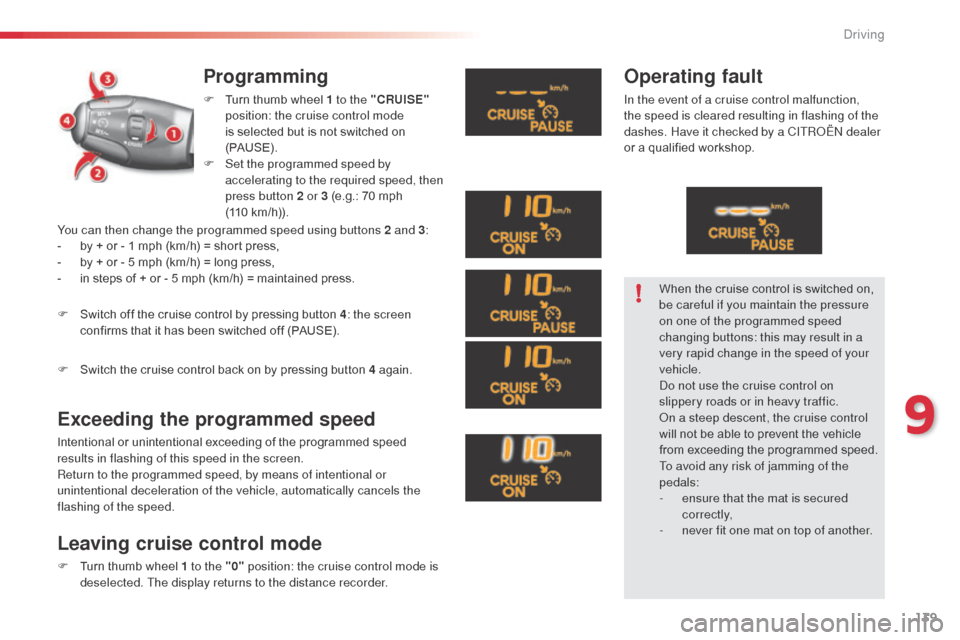
139
Programming
F Turn thumb wheel 1 to the "CRUISE"
position: the cruise control mode
is selected but is not switched on
(PAUS E).
F
S
et the programmed speed by
accelerating to the required speed, then
press button 2 or 3 (e.g.: 70 mph
(110 km/h)).
Exceeding the programmed speed
Intentional or unintentional exceeding of the programmed speed
results in flashing of this speed in the screen.
Return to the programmed speed, by means of intentional or
unintentional deceleration of the vehicle, automatically cancels the
flashing of the speed.
Leaving cruise control mode
F Turn thumb wheel 1 to the "0" position: the cruise control mode is
deselected. The display returns to the distance recorder.
F
S
witch off the cruise control by pressing button 4
: the screen
confirms that it has been switched off (PAUSE).
F
S
witch the cruise control back on by pressing button 4 again.
Operating fault
In the event of a cruise control malfunction,
the speed is cleared resulting in flashing of the
dashes. Have it checked by a CITR
oËn
dealer
or a qualified workshop.
When the cruise control is switched on,
be careful if you maintain the pressure
on one of the programmed speed
changing buttons: this may result in a
very rapid change in the speed of your
vehicle.
do n
ot use the cruise control on
slippery roads or in heavy traffic.
on a s
teep descent, the cruise control
will not be able to prevent the vehicle
from exceeding the programmed speed.
To avoid any risk of jamming of the
pedals:
-
e
nsure that the mat is secured
c o r r e c t l y,
-
n
ever fit one mat on top of another.
You can then change the programmed speed using buttons 2 and 3
:
-
b
y + or - 1 mph (km/h) = short press,
-
b
y + or - 5 mph (km/h) = long press,
-
i
n steps of + or - 5 mph (km/h) = maintained press.
9
Driving
Page 142 of 401

140
Rear parking sensors
Activation
This detects any obstacle (person, vehicle,
tree, gate, etc.) behind the vehicle, except
obstacles located just below the bumper.The system is activated as soon as reverse
gear is engaged, accompanied by an audible
signal. The proximity information is given by:
-
a
n audible signal, which becomes more
rapid as the vehicle approaches the
obstacle.
-
a g
raphic (according to version) in the
multifunction screen, with blocks which
become increasingly closer to the vehicle. On completion of the manoeuvre, when you
exit reverse gear, the system becomes inactive.
An object, such as a stake, a roadworks
cone or any other similar object may be
detected at the beginning of the manoeuvre,
but may no longer be detected when the
vehicle comes close to it.The parking sensor system cannot in
any circumstances be a substitute for
vigilance on the part of the driver.
System consisting of four proximity sensors,
located in the rear bumper.
When the distance between the rear of the
vehicle and the obstacle is less than thirty
centimetres, the audible signal becomes
continuous and the "
da
nger" symbol appears
in the multifunction screen.
driving
Page 143 of 401
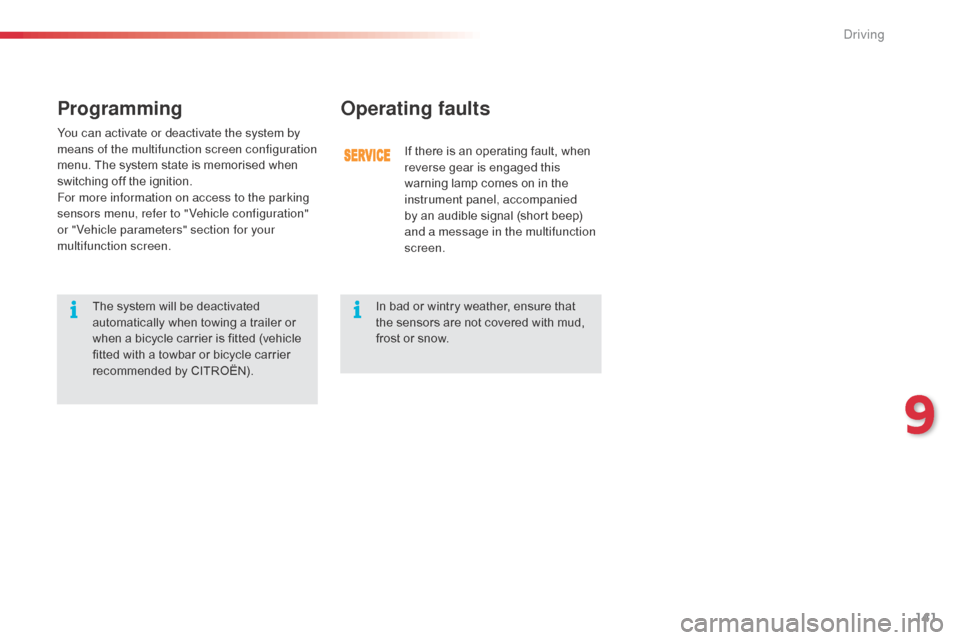
141
You can activate or deactivate the system by
means of the multifunction screen configuration
menu. The system state is memorised when
switching off the ignition.
For more information on access to the parking
sensors menu, refer to " Vehicle configuration"
or " Vehicle parameters" section for your
multifunction screen.
Operating faults
If there is an operating fault, when
reverse gear is engaged this
warning lamp comes on in the
instrument panel, accompanied
by an audible signal (short beep)
and a message in the multifunction
screen.
Programming
The system will be deactivated
automatically when towing a trailer or
when a bicycle carrier is fitted (vehicle
fitted with a towbar or bicycle carrier
recommended by CITROËN).In bad or wintry weather, ensure that
the sensors are not covered with mud,
frost or snow.
9
driving
Page 144 of 401
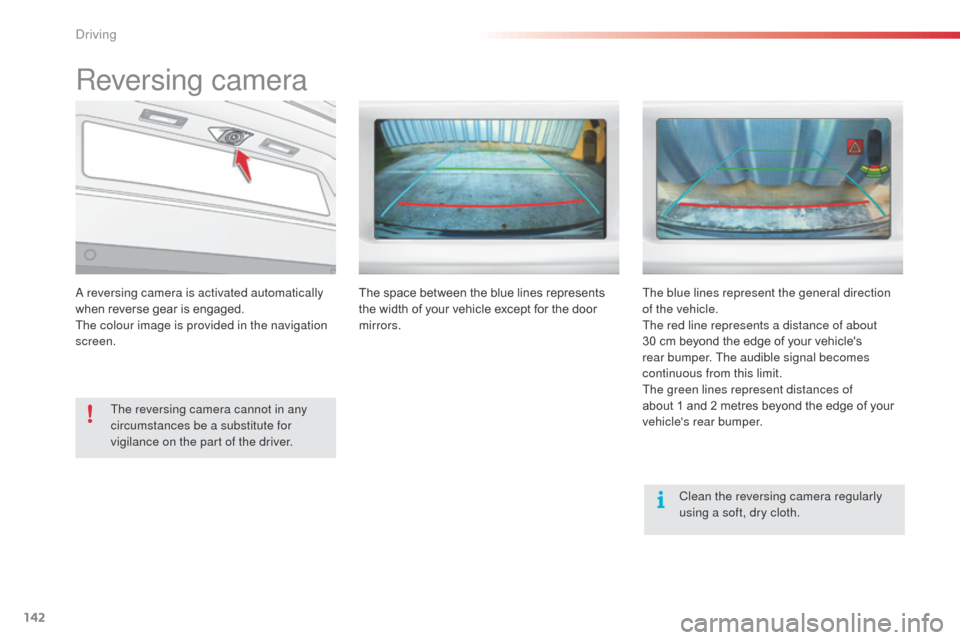
142
Reversing camera
a reversing camera is activated automatically
w hen reverse gear is engaged.
The colour image is provided in the navigation
screen.
The reversing camera cannot in any
circumstances be a substitute for
vigilance on the part of the driver. Clean the reversing camera regularly
using a soft, dry cloth.
The space between the blue lines represents
the width of your vehicle except for the door
mirrors.
The blue lines represent the general direction
of the vehicle.
The red line represents a distance of about
30 cm beyond the edge of your vehicle's
rear bumper. The audible signal becomes
continuous from this limit.
The green lines represent distances of
about 1 and 2 metres beyond the edge of your
vehicle's rear bumper.
driving
Page 145 of 401

143
ToTaL & CITRoËn
Partners in performance
and protecting the environment
Innovation in the search for
performance
For over 40 year, the TOTAL Research and development departments have developed lubricants
for CITR
oËn, t
o match the latest technical innovations
on CITR
oËn
vehicles, both for competition and for
everyday motoring.
For you, this is an assurance that you will obtain the
best performance from your engine.
Optimum protection for your
engine
by having your CITRoËn vehicle
serviced with TOTAL lubricants, you are
contributing towards improving the life
and per formance of your engine, while
also protecting the environment.
10
Checks
Page 146 of 401

144
bonnet
Opening
F Push the exterior safety catch B to the left and raise the bonnet. F
U
nclip the bonnet stay C from its housing,
holding it by its foam protection.
F
F
ix the stay in the notch to hold the bonnet
open. F
T
ake the stay out of the support notch.
F
C
lip the stay in its housing.
F
L
ower the bonnet and release it at the end
of its travel.
F
P
ull on the bonnet to check that it is fully
latched.
F o
p
en the front left door.
F
P
ull the interior release lever A
, located at
the bottom of the door aperture.
The location of the interior release lever
prevents opening of the bonnet while
the front left door is closed.
When the engine is hot, handle the
exterior safety catch and the stay with
care.
be
fore doing anything under the
bonnet, switch off the Stop & Start
system to avoid any risk of injury
resulting from an automatic change to
S T a
R
T m o d e .
Closing
To avoid damaging the electric units,
the use of a high pressure jet wash
under the bonnet is strictly prohibited.
Checks
Page 147 of 401
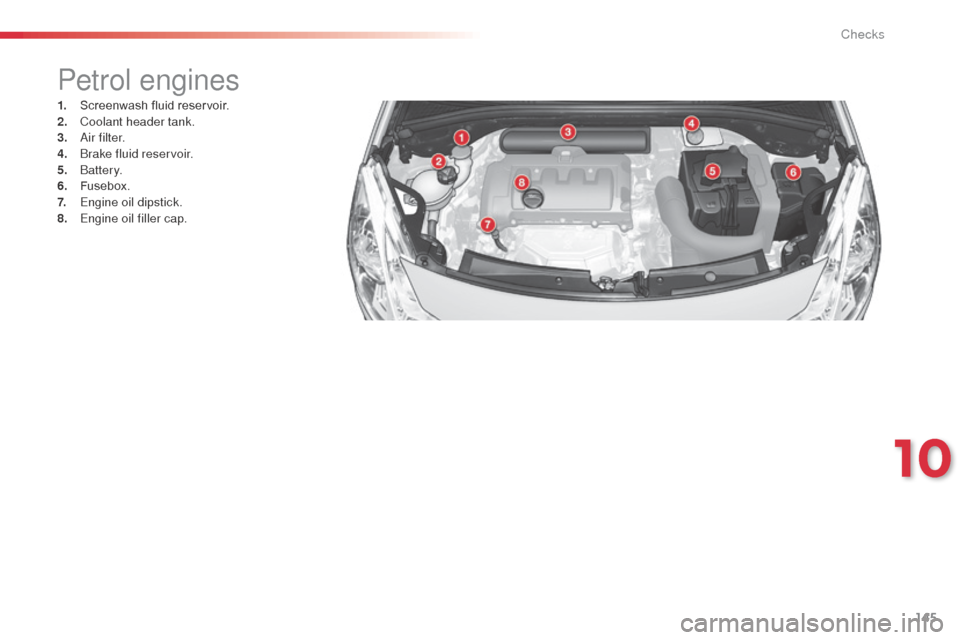
145
Petrol engines
1. Screenwash fluid reservoir.
2. Coolant header tank.
3.
a
i
r f i l t e r.
4.
b
r
ake fluid reservoir.
5.
bat
tery.
6.
F
usebox.
7.
E
ngine oil dipstick.
8.
E
ngine oil filler cap.
10
Checks
Page 148 of 401
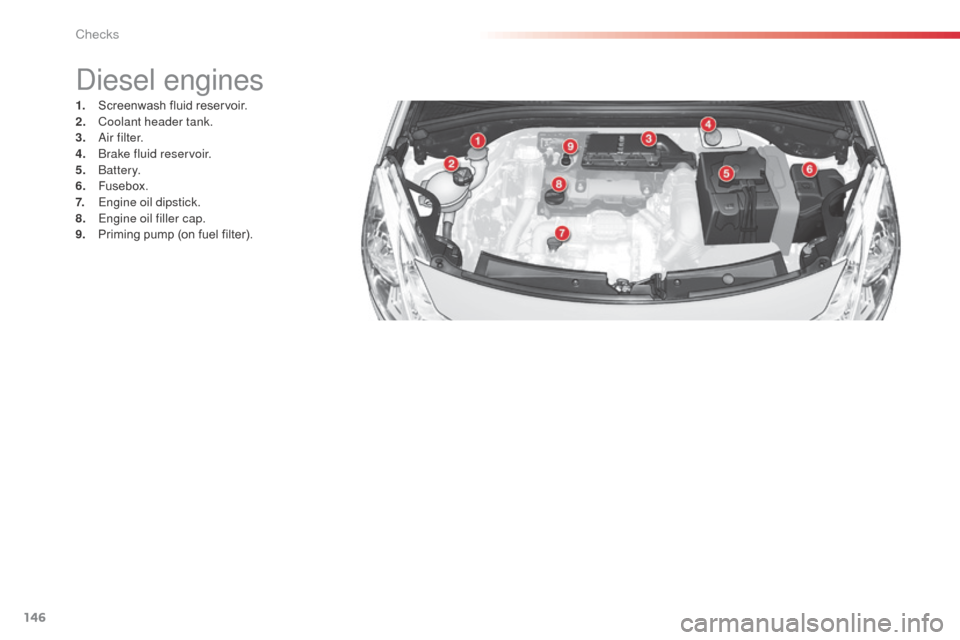
146
diesel engines
1. Screenwash fluid reservoir.
2. Coolant header tank.
3.
a
i
r f i l t e r.
4.
b
r
ake fluid reservoir.
5.
bat
tery.
6.
F
usebox.
7.
E
ngine oil dipstick.
8.
E
ngine oil filler cap.
9.
P
riming pump (on fuel filter).
Checks
Page 149 of 401

147
Checking levels
Engine oil level
The check is carried out either when
the ignition is switched on using the
oil level indicator in the instrument
panel for vehicles so equipped, or
using the dipstick.
Checking using
the dipstick
Refer to the "Petrol engine" or "di esel engine"
section for the location of the dipstick in the
engine compartment of your vehicle.
F
T
ake the dipstick by its coloured grip and
remove it completely.
F
W
ipe the end of the dipstick using a clean
non-fluffy cloth.
F
R
efit the dipstick and push fully down, then
pull it out again to make the visual check:
the correct level is between the marks A
and B .
To ensure that the reading is correct,
your vehicle must be parked on a level
sur face with the engine having been off
for more than 30 minutes.
Check all of these levels regularly, in line with the manufacturer's service schedule. Top them up if necessary, unless other wise indicated.
If a level drops significantly, have the corresponding system checked by a CITROËN dealer or a qualified workshop.
Take care when working under the
bonnet, as certain areas of the engine
may be extremely hot (risk of burns) and
the cooling fan could start at any time
(even with the ignition off).
It is normal to top up the oil level between
two services (or oil changes). CITROËN
recommends that you check the level, and top
up if necessary, every 3 000 miles (5 000 kms). A = MA X
B = MINIf you find that the level is above the A mark or
below the B mark, do not star t the engine
.
-
I
f the level is above the MAX mark (risk
of damage to the engine), contact a
CITROËN dealer or a qualified workshop.
-
I
f the level is below the MIN mark, you
must top up the engine oil.
Oil grade
before topping-up the oil or changing the oil,
check that the oil is the correct grade for your
engine and conforms to the manufacturer's
recommendations.
10
Checks
Page 150 of 401
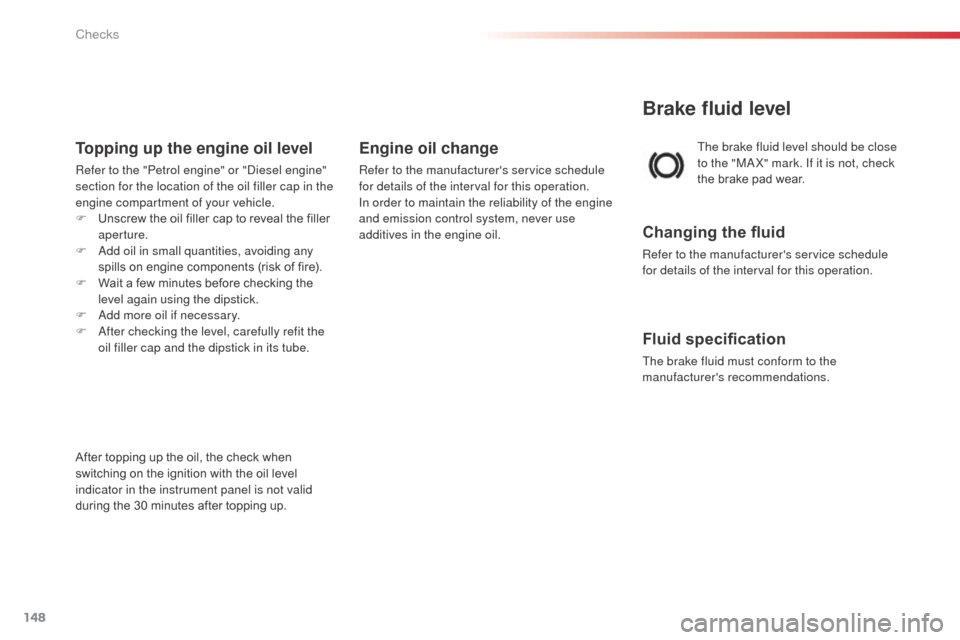
148
The brake fluid level should be close
to the "MaX" mark. If it is not, check
the brake pad wear.
Brake fluid level
Changing the fluid
Refer to the manufacturer's service schedule
for details of the interval for this operation.
Fluid specification
The brake fluid must conform to the
manufacturer's recommendations.
Topping up the engine oil level
Refer to the "Petrol engine" or "di esel engine"
section for the location of the oil filler cap in the
engine compartment of your vehicle.
F
U
nscrew the oil filler cap to reveal the filler
aperture.
F
a
d
d oil in small quantities, avoiding any
spills on engine components (risk of fire).
F
W
ait a few minutes before checking the
level again using the dipstick.
F
a
d
d more oil if necessary.
F
a
f
ter checking the level, carefully refit the
oil filler cap and the dipstick in its tube.
After topping up the oil, the check when
switching on the ignition with the oil level
indicator in the instrument panel is not valid
during the 30 minutes after topping up.
Engine oil change
Refer to the manufacturer's service schedule
for details of the interval for this operation.
In order to maintain the reliability of the engine
and emission control system, never use
additives in the engine oil.
Checks